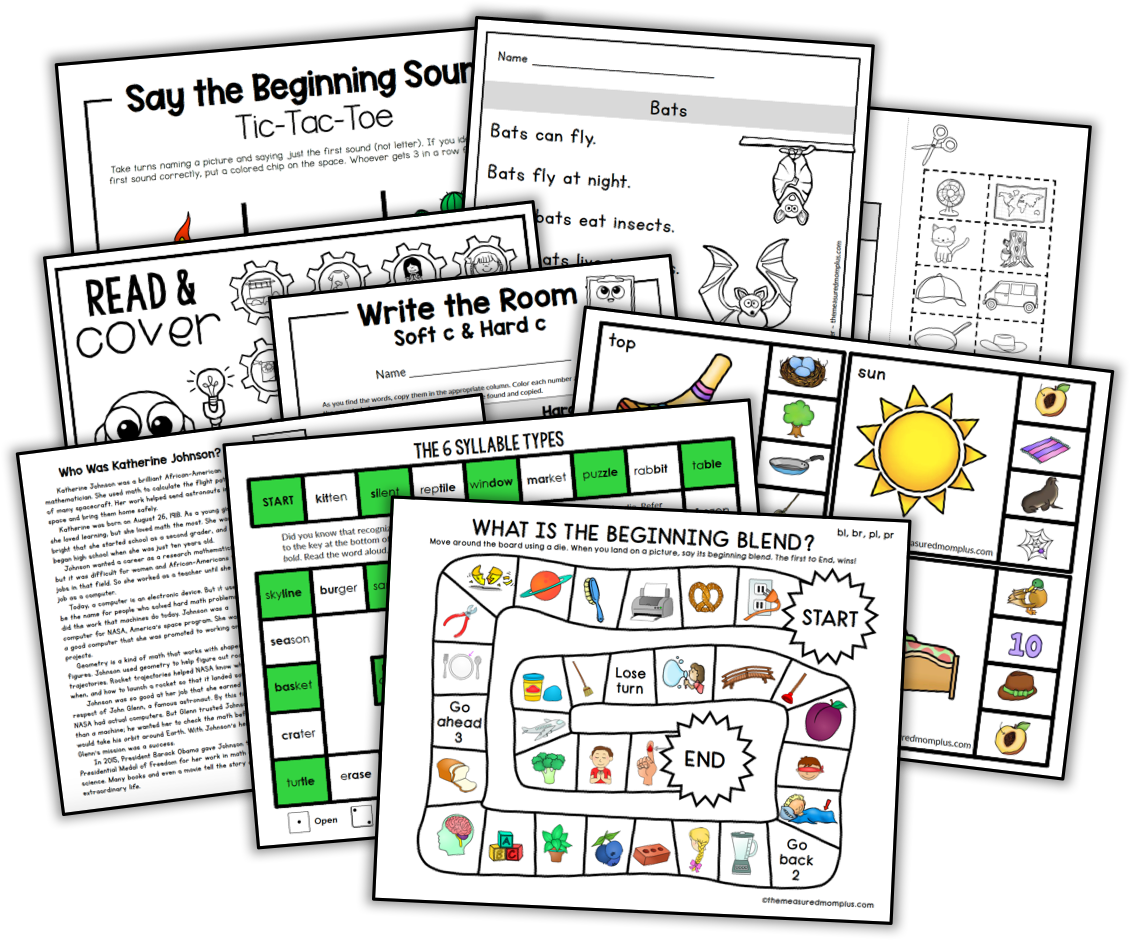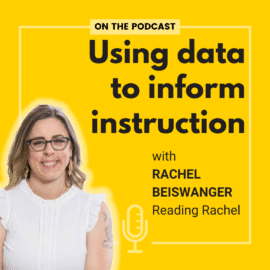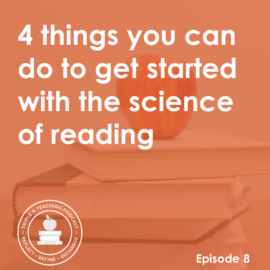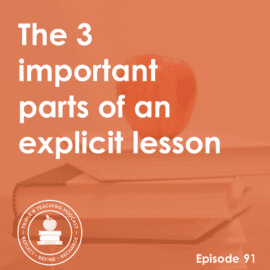
TRT Podcast#42: The difference between balanced and structured literacy
It’s time to take a good look at what we’re doing when we teach children to read. I considered myself a “balanced literacy” teacher for many years. It’s the approach I learned in graduate school, the approach I used as a classroom teacher, and the approach I (used to) teach on my website and in my online course.
However, after a great deal of research into the science of reading, I now see things differently. I now advocate a structured literacy approach to reading instruction.
Listen to the episode here
Full episode transcript
This podcast episode is an audio version of my blog post: What is the difference between balanced and structured literacy?
Balanced and structured literacy are two different approaches to teaching reading. They have things in common, but when they’re referenced in the same breath they’re usually pitted against each other.
I considered myself a “balanced literacy” teacher for many years. It’s the approach I learned in graduate school, the approach I used as a classroom teacher, and the approach I (used to) teach on my website and in my online course. However, after a great deal of research into the science of reading, I now see things differently.
I now advocate a structured literacy approach to reading instruction.
This isn’t to say that I did every single thing wrong as a balanced literacy teacher, or that balanced literacy teachers today aren’t getting anything right. Nor do I think that we have to throw away everything with the balanced literacy label. But it’s time to take a good look at what we’re doing when we teach children to read.
What’s the difference between balanced and structured literacy?
Let’s start with a definition of balanced literacy.
Balanced literacy is a philosophical orientation that assumes that reading and writing achievement are developed through instruction and support in multiple environments using various approaches that differ by level of teacher support and child control.
(Fountas & Pinnell – Guided Reading: Good First Teaching for All Ages)
The fact is, if you ask twenty different balanced literacy teachers to define balanced literacy, you will likely get twenty different definitions. It’s just not well-defined. But most balanced literacy teachers will say (as I did) that they teach reading in a way that meets everyone’s individual needs while also promoting a love of reading.
Balanced literacy came about in the late 90’s as an answer to the whole language and phonics debate. The hope was that it would provide a much-needed compromise by using the best of both approaches. To many people, though, balanced literacy is a dirty word.
What went wrong? Why is structured literacy now coming into favor? Many will tell you that it’s just another pendulum swing. I think it’s much deeper than that.
Let’s start with a definition.
“The term ‘Structured Literacy’ is not designed to replace Orton Gillingham, Multi-Sensory or other terms in common use. It is an umbrella term designed to describe all of the programs that teach reading in essentially the same way.”
(Hal Malchow – International Dyslexia Association)
I used to be a STRONG balanced literacy advocate
Believe me, I never thought I’d be writing an article comparing balanced and structured literacy. I believed in balanced literacy with all of my heart.
I became irritated very angry when I read articles that slammed balanced literacy. The articles said I wasn’t teaching phonics (I was). The articles said I was teaching guessing (I felt that I was teaching my students to be strategic).
The articles said I should be doing more explicit instruction (I felt that my mini-lessons served that purpose just as well as a 30-minute whole class lesson that would likely bore half my class).
The articles criticized my lack of a structured curriculum (I felt that I knew my students much better than a scripted curriculum any day). The articles said balanced literacy didn’t work. I had plenty of anecdotal evidence that it did.
Here’s the thing. And this is something we all need to take note of.
Balanced literacy works for some children. Many children DO learn to read without a lot of explicit instruction.
But it doesn’t work for others.
Explicit instruction is good for all children. It’s absolutely essential for many of them.
In other words? If we use a balanced literacy approach, we will not reach all of our students.
Here’s the key difference between balanced and structured literacy
Balanced literacy is centered around activities that surround children with quality literature and promote a love of reading, whereas structured literacy teaches the structure of language through explicit, systematic, sequential instruction.
Balanced literacy teachers typically teach the essential components of reading (phonological awareness, phonics, fluency, comprehension, and vocabulary) through the following structures: read aloud, shared reading, guided reading, and independent reading.
Teachers tend to be more focused on the activities themselves than on the skills.
On the other hand, structured literacy teachers may include read aloud, shared reading, small group instruction, and independent reading in their days, but they are focused less on activities and more on the structure of language: phonology, sound-symbol correspondences, syllables, morphology, syntax, and semantics.
A summary of the differences between balanced and structured literacy
I know that not everyone will agree with my characterizations in the following chart, but this is how I see it. Let’s tackle the differences one by one.
Difference #1: In balanced literacy, we typically see a haphazard approach to phonemic awareness instruction. Structured literacy includes systematic, sequential instruction in phonemic awareness.
Through the work of David Kilpatrick, we’ve learned that phonemic awareness may very well be the missing key for struggling readers. It’s essential that we give daily lessons in phonemic awareness.
Our students need lessons in phoneme isolation, blending, segmenting, and manipulation.
If you’re a balanced literacy teacher, an important change you can make is to do ten minutes of phonemic awareness instruction every day.
Difference #2: In balanced literacy, phonics lessons are typically quite short and may not follow a scope and sequence. In structured literacy, phonics is taught through an explicit, systematic and sequential approach (usually through a purchased curriculum).
As a new first grade teacher, I had to use a scripted phonics program that I HATED.
It moved too quickly for my low readers, and it was immensely boring for my strong ones.
And it took way too much time out of our school day.
I received permission to ditch that program in my second year of teaching first grade, and from then on I had a very “I’ll teach it when you need it” approach to phonics.
I’m fully aware that many balanced teachers DO have a structured approach to teaching phonics, and I say hurray for them!
But it’s not the norm.
A strong phonics lesson is 20-30 minutes long and has most, if not all, of the following components: a phonemic awareness warm-up that connects to the phonics skill, explicit introduction of the new sound-spelling relationship, blending practice, word building, practice reading decodable text, and guided writing practice. (And while there are still pretty boring phonics programs out there, there are many hands-on programs that allow you to meet multiple levels in one classroom.)
Difference #3: Balanced literacy teaches rote memorization of high frequency words. In structured literacy, high frequency words are taught according to their phonics patterns, and even irregular words are taught explicitly.
For years I thought it made perfect sense to teach kids to memorize long lists of high frequency words. That’s why I created a whole series of sight word books that taught high frequency words through repeated exposure.
I’ve since removed those books from the website because I’ve learned that this isn’t the best approach for teaching high frequency words.
After all, kids don’t store thousands of whole words in their brains. That’s not how the brain learns to read.
A better approach is to teach a small number of “sight words” to get kids started (such as the and is), and to teach the rest when you teach their related phonics patterns.
As for irregular words, you can still be explicit about teaching them.
Difference #4: In a balanced literacy classroom, beginning readers read leveled texts using the three-cueing system. In a structured literacy classroom, early readers read decodable texts that include already-learned phonics patterns.
This difference right here is the one that made me realize I could no longer support a balanced literacy approach.
If you consider yourself a balanced literacy teacher and do not teach your students to solve words using the picture, context clues, first letter (and anything else other than sounding out the word), please comment below … because as far as I know this type of teacher does not exist.
I never EVER thought I’d denounce three-cueing, but after studying the science of reading I can no longer support it.
If this makes you bristle (believe me, I know how you feel), I encourage you to listen to my podcast episode, What’s wrong with 3-cueing?
For years I resisted decodable books because I was sure they would kill a love of reading before it could start.
After all, wasn’t every decodable book boring, stilted, and nonsensical?
Turns out … I was wrong! There are actually many quality decodable books just waiting for you to discover them.
Difference #5: In a balanced literacy classroom, there is typically a greater focus on the meaning of the text rather than on the accuracy of what is read. Structured literacy teachers correct misread words; they encourage their students to sound them out.
This sounds crazy, but for years I believed that “sound it out” should only be said as a last resort.
I thought that it was much better to ask my students to consider what made sense … because isn’t reading all about comprehension?
(Well, yes it is, but reading comprehension is a product of decoding and language comprehension. See this podcast: What the science of reading is based on)
I think that the traditional use of running records leads many balanced literacy teachers to believe that getting the general meaning right is more important than sounding out every single word.
For that reason, I recommend rethinking running records.
Difference #6: Balanced literacy teachers believe that students get better at reading by reading. Structured literacy teachers will tell you that students get better at reading by learning and practicing the code.
This one is a little tricky. Kids need to practice reading, whether or not they’re in a balanced literacy classroom.
But first they need to learn to decode the words, which they learn through explicit instruction.
As a balanced literacy teacher, I had my students fill their bags with “just right books” (i.e. leveled books that required them to use three-cueing to solve the words) because I thought that they more they “read,” the more they’d pick it up.
Now I know that after kids have developed the habit of connecting the phonemes to the graphemes (sounding out words), reading practice will help them orthographically map the words (i.e. store them in their brains for future, instant retrieval).
Difference #7: Balanced literacy teachers believe that the point of reading instruction is to get children to love reading. Structured literacy teachers believe that the point of reading instruction is to teach children to read.
This is NOT to say that balanced literacy teachers aren’t concerned with teaching children to read.
Of course they are.
This is NOT to say that structured literacy teachers don’t want children to love reading.
Of course they do.
But structured literacy teachers understand something I didn’t “get” for a long time.
Success breeds motivation. (That’s a quote from Anita Archer in a podcast episode from The Reading League.)
When you teach children to read, and they see that they can do it … that they are actually pulling those words off the page by connecting the sounds to the letters, THAT is what gets them excited about reading.
This may be my longest blog post ever, so it’s time to wrap it up. Before I do, though, I want to address a few criticisms of each approach.
Critics of balanced literacy say that it’s haphazard, teaches bad habits, and puts the cart before the horse.
These criticisms were immensely insulting to me not so many months ago. But now I get it. By not teaching skills in an explicit, systematic way, I was missing many of them.
By teaching my students to use the picture or context to solve words, I was teaching them habits that would not serve them when they got into third grade (and the harder texts that came with it).
By thinking that we needed to focus FIRST on comprehension, I was putting the cart before the horse. (I was expecting them to comprehend what they couldn’t even read!) I had to teach them decoding first. Once their decoding became more automatic, they could develop fluency. Then comprehension came into play.
Critics of structured literacy say it’s boring and drill-and-kill. They claim that it stifles fluency, ignores comprehension, and kills the love of reading.
I’m not making this up. These were my criticisms of structured literacy.
Now I know that explicit, systematic teaching does not have to be boring. When a knowledgeable, engaging teacher combines the art of teaching with the science of reading, joyful learning can result.
Now I know that while it’s a little painful to hear kids sounding out every word (instead of flying through predictable texts), it’s a necessary part of the process. I learned that we can focus on comprehension when a child can sound out words quickly enough to remember what was read. Until that time, we focus on comprehension through interactive read alouds.
And through conversations with a principal, school psychologist, and many former balanced literacy teachers, I finally get it.
We’ve got to teach kids to read before they can love it.
Sign up to receive email updates
Enter your name and email address below and I'll send you periodic updates about the podcast.
Related links
- Original blog post: What’s the difference between balanced and structured literacy?
- The Reading League podcast episode: Interview with Anita Archer







Dave Smith
HI Anna. I think I’m the kind of teacher you’re asking for a comment from. So… I guess I’m “balanced literacy” but at the same time… yes, phonics needs to be explicitly taught and I always have, just usually not with a corporate produced program (and sometimes with things I’ve downloaded from your site… keep up the good work!).
I guess I’ve always had my students memorize sight words (and the thing is, they can and do remember them, lists of them actually, even the struggling readers I work with as a special ed teacher)… but I’ve also always encouraged my students to “sound them out.”
3 cueing system? Read, read, red. Brown, grown. Tough, bough. Phonograms (a balanced literacy thing) suck. How does a new reader know which pronunciation to use? Semantics. Syntax (is it a verb or a noun and why do you think so?). It’s the VISUAL cue that many BL teachers over-rely on, I guess. And that’s too bad.
Lots of reading? Good fit books? I still use the concept everyday in my classroom. Structured literacy teachers would want to see “decodeable” books be the sole type of book in a primary school classroom library like mine. But you know what? I find that so-called “leveled” books are decodeable too! Even with some repetition of words in there, in most of the Level E decodeable books in my classroom, kids need to: decode long vowel words, know or decode approximately 12 different high frequency words, some VCCV words, and plenty of CVC words. No matter what text you use, there is no escaping phonics. The difference would be in execution. Does the teacher just tell the students to guess at the word? Use the picture? Just use the first letter? Ignore the rest? When a student guesses at the first letter and says “house” for “horse”, I immediately cue with something like, “Hmm. House? I see an r. Try it again.” If they can’t seem to get it right, I’ll say something like, “There’s a little sight word in the middle of that word (or). Do you see it?” I guess this is a BL method… but it’s also phonics. After decoding happens, I’ll wrap up this teachable moment by saying something BL like, “You know something, I’m glad you figured it out. Because that cowboy would get awful sore riding a house instead of a horse.” That’s the semantic cueing system… but I say it AT THE END and not the beginning to reinforce the fact that making meaning is ultimately the purpose of reading.
Yes, phonics first. Always. But there is nothing inherently wrong whatsoever with your sight word readers or ANYTHING you’ve ever put on your website. And since I know you’ve taught your own kids to read well, you know BL works for the vast majority of readers. We’re talking about a persistent 30% approximately who don’t pick up the code on their own fairly easily. That is the percent I teach, and I strongly emphasize the code and always have. But I haven’t had to throw everything BL away to do it. It’s execution, pure and simple.
I suppose my final thought would be this: keeping kids safe from books that we adults feel they’re not ready for (because they may have spelling patterns we haven’t explicitly taught them yet) is a strange thing to fear. That said, I’d question a student of mine who thinks they can read Harry Potter. Of course, they can’t. They can barely decode a word like “blame.” But I think it rather silly to protect them from words like “monkey” or “refrigerator” that might pop up in a leveled book. They will, on their own, struggle with the word. They might even “guess” at the word. A picture may even cue them to what it means… though again, I’ve never been big into telling kids to rely on pictures. But if so, okay. It is not the end of their world if they guess it or even skip it. I can’t be the word police.
It’s a tough call. In the average second grade classroom, for example, the majority of kids will already be able to decode fluently and even spell accurately most of the phonetic patterns you would be teaching in a highly structured, systematic phonics program. And those take so much time to do whole group, that other learning gets squeeze out (the learning about things, people, places… the background knowledge that is so crucial to later reading comprehension). It’s dreadfully boring for kids… even though it’s very necessary for the few in the room who need it. Striking the balance is tough.
Have a good day!
Anna Geiger
Thank you for your thoughtful comment, Dave! A few thoughts:
1- I agree; most if not all balanced literacy teachers fully acknowledge that phonics must be taught.
2- Frankly, not all researchers say that students shouldn’t memorize “sight words.” This issue is that it will be much more effective when we draw students’ attention to sounds and spellings. And we also know that students can only successfully memorize a limited number of words. But I’m glad your students are having success with your method!
3- The issue with the three-cueing theory is that it’s based on the belief that skilled readers don’t look at all the letters as they read and mostly read by using syntax and semantics. However, we know from eye movement studies that skilled readers do, indeed, look at all or almost all of the letters in each word, and pay attention to all the words, except sometimes function words. In addition, we want students’ eyes on the words themselves so that they sound them out and so orthographic mapping can occur. That said, we can and should absolutely CHECK our reading using syntax and semantics, as you noted. But we attempt to read the word first. Unfortunately, as you noted, many teachers (I include my former teaching self here) draw attention to context FIRST, because they’re giving their students texts with too many phonics patterns they don’t know. With these particular texts and beginning readers, three-cueing is the only way TO “read” the words!
4- The thing about decodable texts is that they are only decodable for a child if they child has been taught most of the sound-spellings within them. So, yes, any book is decodable for you and me, but not necessarily for the child in front of us. We need to choose first texts carefully so that students can actually practice the skills we’ve taught them – or they’ll start to see those skills as useless and take the easier way out, which is guessing using context and pictures. I think that some teachers are keeping kids in decodable texts too long; I hope that research will help us navigate this better.
5- According to Nancy Young’s Ladder of Reading (backed by research), learning to read is relatively easy for up to 45% of kids. That leaves over half of our students who need a more structured approach.
6- The reason I took those sight word books down is because they were designed based on (my) flawed understanding of how reading works. You can’t convince me there was nothing wrong with them. 😉
7- I don’t think we should stop kids from accessing text we haven’t taught them to read – or we’d have to cover their eyes! But I do think we need to be careful and intentional about the texts we have beginners read for practice.
8- 2nd grade is tricky, especially these days when many second graders are behind because of school closures two years ago. But without these gaps, I would think that a typical second grader would need less phonics and little decodable text. You’re right – striking the balance is tough.
Thank you again!
Kathi Haller
Thank you for articulating what I’ve always known about “structural reading”. It’s the way I learned to read back in 1961 when most the nation’s children were literate.
I homeschooled for 18 years and used a program called “Read Write Sing and Spell” which I still use at the public school I teach at for RTI. It is fun and colorful and uses music. Who doesn’t remember jingles from commercials of their childhoods?
Again, you did a beautiful job explaining why structural literacy is best!
Anna Geiger
Thank you for sharing a program that worked for you, Kathi, and for your kind feedback! I’m so glad to hear that structured literacy worked well for you.